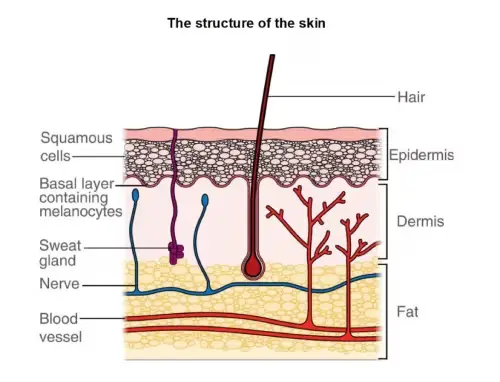The skin is the body’s largest primary protective organ made of water, protein, minerals and fats. It covers the entire external surface of the body and serves as a first-order physical barrier against the environment.

There are several types of cancer that can affect the skin. They are divided into two main groups, depending on the cell they develop from, and include:
- non-melanoma skin cancers
- melanoma skin cancers
The most significant risk factor for developing skin cancer is ultraviolet light (UV) exposure. It is important to protect the skin from excessive sun exposure (including sunbed use) to minimise the risk of developing skin cancer in the future.
Non-melanoma skin cancers
Non-melanoma skin cancer is a common type of cancer that starts in the top layer of the skin. The two main types of non-melanoma skin cancers are basal cell carcinoma (BCC) and squamous cell carcinoma (SCC). Both BCC and SCC are related to cumulative lifetime sun exposure and are more frequently diagnosed in older individuals. They often develop on sun-exposed areas of the skin.
BCC is the most common type of skin cancer in the UK, and it starts in skin cells called basal cells. It is a very slow-growing tumour, which does not spread to other parts of the body, but can cause symptoms such as bleeding, crusting and ulceration if not treated.
SCC is the second most common type of skin cancer, and it develops from the squamous cell layers of the skin. It generally presents as a scaly, crusty nodule, which can be painful or sore. SCC has the potential to spread to other parts of the body.
Other, much rarer, types of non-melanoma skin cancer include:
- Kaposi’s sarcoma
- cutaneous lymphoma
- Merkel cell carcinoma
Common symptoms of non-melanoma skin cancer include:
- a growth or unusual patch on the skin
- a sore that doesn’t heal
- bleeds or scabs for more than 4 weeks
Treatment for non-melanoma skin cancer at CUH
The treatment you have depends on several factors, which include:
- the type of skin cancer
- the location of the cancer
- the stage of the cancer
- if the cancer has spread
- your general health
A team of specialists at CUH will meet to discuss your condition and to make a recommendation about the best possible treatment for you.
You, along with your clinician, will then discuss your treatment recommendations at the clinic appointment and decide on the right treatment plan for you. Your clinician will explain different treatment options and possible side effects.
The treatment for non-melanoma skin cancer can include:
- surgery
- radiotherapy
- chemotherapy
Surgery is usually the main treatment for both basal cell carcinoma and squamous cell carcinoma. The surgery often involves removing the lesion with a small area (few mm) of normal skin around it, to ensure cancer is fully removed. The skin is then closed with stitches (and possibly a skin graft or skin flap if the area is large). Under most circumstances, this is done under local anaesthetic as an outpatient procedure.
Surgery may also be needed if the cancer has spread to other areas of the body or if it has come back again, after being removed.
Radiotherapy can be used to treat SCC and BCC, which involves shining X-rays onto the skin over several sessions. This may be recommended if the skin cancer covers a large area, and surgery may be difficult or disfiguring.
At times, you may require more than one treatment or a combination of different treatments to give the best chance of long-term cure and to help reduce the risk of the cancer coming back.
Melanoma skin cancers
Melanoma is a type of skin cancer that starts in cells called melanocytes, which make melanin that gives our skin its colour. Melanocytes can be found in the skin, the layer of tissue lining some parts of the body (mucous membrane) and the eye. Melanoma in the skin can start in a mole or in normal-looking skin, including the palms and soles or under the nails, and can spread to other areas of the body.
The ABCDE checklist is helpful to identify some of the signs of a possible melanoma:
- A – asymmetry - refers to the shape of the mole. Melanomas are more likely to be asymmetrical with the two halves have different shapes or sizes within it
- B – border - refers to the edge of the lesion. Melanomas are more likely to have irregular or jagged edges.
- C – colour – melanomas may contain several colours within it, not just brown. They may have shades of pink, white, grey, brown or black. Two or more colours within a mole may be concerning.
- D – diameter - greater than 6mm
- E – evolving, i.e. the lesion is changing – in size, shape or colour. The lesion may also be symptomatic, such as itching or bleeding. (These symptoms are not specific for melanoma, but may be of concern).
Treatment for melanoma skin cancer at CUH
The treatment you have depends on several factors, which include:
- the location of the cancer
- the stage of the cancer
- if the cancer has spread
- your general health
A team of specialists at CUH will meet to discuss your condition and to make a recommendation about the best possible treatment for you.
You, along with your clinician, will then discuss your treatment recommendations at the clinic appointment and decide on the right treatment plan for you. Your clinician will explain different treatment options and possible side effects.
The treatment for melanoma skin cancer can include:
- surgery
- radiotherapy
- targeted therapy
- immunotherapy
Surgery is the main treatment for melanoma. To begin with, the mole (that is suspicious for melanoma) is removed with 2mm of normal skin around it, to ensure the lesion is fully removed. Once it has been analysed under the microscope, and the depth of the melanoma is confirmed, further surgery to remove a wider area of normal skin (known as a wide local excision) can be suggested to reduce the chances of the melanoma coming back.
Depending on the stage of the melanoma, you may also be offered a sentinel lymph node biopsy, to see if the melanoma has spread to the local lymph nodes.
If a large area of skin is removed, skin may need to be taken from another part of the body and used to cover the area where the melanoma was. This is known as a skin graft.
Most patients diagnosed with melanoma will require regular follow-ups in clinic to monitor for recurrence.
At times, you may require more than one treatment or a combination of different treatments to give the best chance of long-term cure and to help reduce the risk of the cancer coming back.
If you've been diagnosed with advanced melanoma, it might be very hard to treat. It may even not be possible to cure the cancer. In this situation, the aim of your treatment will be to limit the cancer and its symptoms, and help you live longer.
Resources and support
- Non-melanoma skin cancer - NHS (opens in a new tab)
- Basal Cell Carcinoma (BCC) – BAD (opens in a new tab)
- Squamous Cell Carcinoma (SCC) - BAD (opens in a new tab)
- Melanoma skin cancer - NHS (opens in a new tab)
- Sunscreen and sun safety - NHS (opens in a new tab)
- Cancer support service
- Macmillan (opens in a new tab)
- Cancer Research UK (opens in a new tab)

